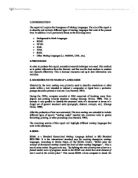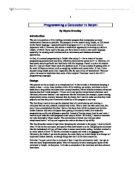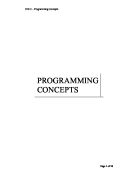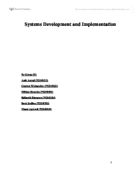Human Computer Interaction Project.
Human Computer Interaction Project Evaluation of Olympus C1400l Digital Camera Group Members: Lorna Brodbin 9838635 Jean Cronin 9838856 Gillian O'Sullivan 9840435 . Introduction "Every picture tells a story" An old saying that holds true. A picture can tell us more in an instant than a thousand words ever could. A picture records emotions, expressions, feelings and conveys them easily to the onlooker. Photographs capture hundreds of years of history be it on a world scale or at a personal level. We capture our weddings, births, birthdays and other occasions dear to us on camera because we want to hold on to that moment forever. Every time we look at a photograph we remember that day and relive that moment. The camera never lies. It takes a moment in time and freezes it. We rely on photographs as a tool to help us to understand and to remember the history of the world. Most of the worlds great historical events have been captured on film. A photograph of an innocent victim of war makes the victim real, like someone we knew rather than a name in a paper, and touches us far more deeply than stories in a book. Peoples descriptions of events are often tainted by exaggeration, imperfect memories and personal opinions but there is no denying the evidence of a photograph. The camera has come along way since the days of Niepcei. The first cameras were big and
Creating a database system for Mr Azizur Rahman, Mr Bilal Sheikh and Mr Iman Ahmed who are part of their own computer-upgrading business, called N.E.T
CONTENT TABLE ANALYSIS 3 .1 INTRODUCTION AND BACKGROUND INFORMATION 3 .2 THE CURRENT SYSTEM & PROBLEMS WITH THE SYSTEM 3 .3 QUESTIONNAIRE 10 .4 OBJECTIVES OF THE NEW SYSTEM 10 .5 DATAFLOW DIAGRAM OF CURRENT SYSTEM 11 .6 INPUT REQUIREMENTS 12 .7 STORAGE 12 .8 PROCESS REQUIREMENTS 12 .9 OUTPUT REQUIREMENTS 13 .10 DATA DYNAMICS 13 .11 SUB-TASKS 13 .12 PERFORMANCE INDICATOR 13 .13 HARDWARE & SOFTWARE REQUIREMENTS 14 .14 SYSTEM OVERVIEW 15 .15 USER'S SKILL LEVEL 15 .16 PLAN OF PROJECT COMPLETION 15 .17 CRITICAL PATH DIAGRAM 16 2 DESIGN 18 2.1 POSSIBLE SOLUTIONS 18 2.2 FINAL CHOICE OF SOFTWARE 18 2.3 DATA FLOW DIAGRAM OF PROPOSED SYSTEM 19 2.4 NORMALISATION 20 2.5 TABLE DESIGN 22 2.6 QUERY DESIGN 24 2.7 FORM DESIGN 26 2.8 REPORT DESIGN 27 2.9 MACRO DESIGN 27 2.10 SECURITY & BACK UP 27 2.11 GANTT CHART 28 2.12 TEST STRATEGY 28 2.13 TEST PLAN 29 3 IMPLEMENTATION 33 3.1 COMMENTARY ON IMPLEMENTATION AND IMPROVEMENTS 33 3.2 IMPLEMENTATION PLAN 34 4 TESTING 71 4.1 IMPROVED TEST PLAN 71 4.2 COMMENTARY ON TESTING 76 5 EVALUATION 90 5.1 LIMITATIONS 90 5.2 FUTURE ENHANCEMENTS 90 6 USER MANUAL 91 Analysis .1 Introduction and background information As part of my A2 ICT project I will be creating a database system for Mr Azizur Rahman, Mr Bilal Sheikh and Mr Iman Ahmed who are part of their own computer-upgrading business, called N.E.T (New
Explain the Emergence of Markup Languages.
.INTRODUCTION The report will explain the Emergence of Markup Languages. The aim of the report is to describe and evaluate different types of markup languages that exist at the present time. In addition, it will particularly focus on the following areas: * Background to Mark Languages * SGML * HTML * XML * WML * SMIL * Other Markup languages (i.e. MathML, CML, etc.). 2.PROCEDURE In order to produce this report, secondary research technique was used. This enabled us to gather information from the Internet, and this was the best medium to conduct our research effectively. This is because resources and up-to date information was available. 3. BACKGROUND TO MARKUP LANGUAGES Historically, the term markup was primarily used to describe annotations or other marks within a text intended to instruct a compositor or typist how a particular passage should be printed or laid out ( Lou Burnard, 1995). During the 1970s, computer scientist at IBM conceived of breaking away from display and printing towards structural markup (George Dillion, 1999). This is because it was possible to identify the structural units of a document in terms of a (large) set of general structural units (paragraph, abstract, example, etc.). (George Dillon, 1999). After the production of text was automated. The term markup was extended to include different types of special "markup codes" inserted into
to help in the selection of tools that support the software quality management process.
The objective of this article is to propose a set of metrics to support the selection of tools for software quality management. The feature analysis case study evaluation method was used as a framework, selected by applying the DESMET method, specially developed to evaluate software engineering methods and tools. As a result of this research, a set of 16 features with 59 metrics has been formulated to help in the selection of tools that support the software quality management process. The features proposed were applied to nine software tools selected from those available in the market. The result was a wellfounded decision for selecting a tool that was best suited for the specific needs of the organization. Key words: quality features, quality management, software engineering tools, software process quality, software product quality, strategic planning INTRODUCTION For software products, quality must be built in from the beginning; it is not something that can be added later. To obtain a quality software product, the software development process must also reach some quality level. Some international evaluation norms and models for software quality are centered in product quality, while others are centered in process quality. In the first group, ISO/IEC 9126 (JTC 1/SC 7 991) and the Dromey (1995) model can be included. In the second group,
3SFE504 - Object Oriented Programming - Linear and Independent Hash Table code
School of Informatics DEPARTMENT OF INFORMATION SYSTEMS AND COMPUTING 3SFE504: Object oriented programming COURSEWORK Student Id Student First Name Student Surname 2007053 Kavindya Isuru 2007020 Malshani Nanayakkara CONTENTS Page Introduction 3 Implementation Group Work 5 Student A Implementation 10 Assumption 24 Student B Implementation 25 Testing Student A: Test Plan 44 ScreenShots 45 Student B: Test Plan 50 ScreenShots 51 Self-Evaluation Individual Reports 59 INTRODUCTION This coursework was done in teams' of two group members. Group V was made of up of: N.T. I Kavindya and Malshani Nanayakkara In this project, we were asked to create a dictionary object, which was capable of storing words and its definitions. Each word could contain more than one definition. The dictionary object we created should contain the facilities of viewing the words in the dictionary, adding new words, searching new words and printing it to a file. The words and their definitions would be stored in an external file called 'defs.dat'. So every time, our application is run, the words and their definitions should be read in. We each created a hash table to accommodate these. Student A's part, done by Kavindya, reads in the word and stores them using the linear rehashing technique. Student B's part, done by Malshani, stores the words in the hash table using
Programming a calculator in Delphi.
Programming a Calculator in Delphi By Wayne Broadley Introduction The aim is to produce a fully working calculator program that incorporates as many mathematical features as possible. The program is to be created using Delphi, an IDE based on the Pascal language. I personally prefer to program in C++ as I have quite a lot of experience with it. However, this seems a worthwhile opportunity to develop my skills in Delphi, of which I have used in the past, and have found it to be a very useful language especially for creating small utilities (such as calculators) and database-orientated applications. At first, it's unusual programming in Delphi after using C++ for so many of my past programming projects (and also Java, which has fairly similar syntax to C++). However, it's been pretty easy to get back into familiarity with the language. Pascal is quite a bit simpler than C++ and so it hasn't been much of a problem at all. It's just a matter of getting some of the small differences correct, such as assigning variables and syntax order. In fact, I have enjoyed using Delphi quite a lot; I especially like the ease of use of 'procedures'. They are quite a lot easier to implement than some of the complex 'functions' used in the C/C++ programming languages. Design This project can be as simple or as complicated as I'd like to make it. Sometimes keeping it simple is best - a nice,
MS Office solutions. Fantasy mobiles require: An excel spreadsheet with two work sheets; Inventory & Monthly Sales GUI to update stock quantities on the first worksheet GUI to calculate total and average sales of a
MS Office Development Contents . Introduction 3 2. Task A 4 2.1 System requirements 4 2.2 Prototyping 4 2.3 Implementation part 1 6 2.4 Functional Testing 10 2.5 Logical Testing 10 2.6 Implementation Part 2 12 2.7 Functional Testing 15 2.8 Logical Testing 15 3. Task B 17 3.1 System Requirements 17 3.2 Prototyping 17 3.3 Implementation 18 3.4 Functional Testing 19 4. Task C 20 4.1 System Requirements 20 4.2 Pseudocode 20 4.3 Implementation 20 4.4 Testing 22 5. Evaluation 24 5.1 Evaluation of the Solutions 24 5.2 Self Evaluation 25 6. Bibliography 26 6.1 Books 26 6.2 Websites 26 6.3 Online Articles 26 6.4 Other 26 . Introduction Microsoft Office is an office suite of related applications. VBA (Visual Basic for Applications) is an advanced feature which can be used within the office suite applications to develop solutions for office environment problems. When coming from a VB.Net background, you have a head start but nonetheless there is still a learning curve to undergo. The VBA object library also differs from version to version of Microsoft Office making it more complicated for developers. The crux of VBA is that it allows automation of already featured tasks found in the MS office applications. Its major benefit comes from the fact that by hitting a key, or clicking a button, it can initiate and complete an entire process removing many
Programming Concepts. Andora Video is a small shop selling videos. The owner, Raul, wishes to develop a sales transaction processing system. The main objective of this system should be to display the total price of the sale after discounts, tax e.t.c.
PROGRAMMING CONCEPTS Table of Contents INTRODUCTION 3 SCENARIO 3 USER REQUIREMENTS 3 INFORMATION 3 GUI (GRAPHIC USER INTERFACE) 4 VERSION 1 5 REQUIREMENTS 5 DATA TABLE 5 DESIGN PSEUDOCODE 6 IMPLEMENTATION (v. 1) 6 TESTING 8 Syntax Errors 8 Logical Errors 8 VERSION 2 10 REQUIREMENTS 10 DATA TABLE 10 DESIGN PSEUDOCODE 11 IMPLEMENTATION (v. 2) 11 TESTING 13 Syntax Errors 13 Logical Errors - Order 1 15 Logical Errors - Order 2 (first attempt) 15 Logical Errors - Order 2 (second attempt) 16 VERSION 3 17 REQUIREMENTS 17 DATA TABLE 17 DESIGN PSEUDOCODE 18 FINAL IMPLEMENTATION (v. 3) 18 TESTING 21 Database connectivity 21 EVALUATION 22 CONCLUSION 22 BIBLIOGRAPHY 23 BOOKS 23 WEBSITES 23 SOFTWARE 23 INTRODUCTION SCENARIO Andora Video is a small shop selling videos. The owner, Raul, wishes to develop a sales transaction processing system. The main objective of this system should be to display the total price of the sale after discounts, tax e.t.c. This should occur as a result of the input of data surrounding the video and its purchase. USER REQUIREMENTS * An application that is able to process multiple video titles * Calculates discounts, VAT and totals * Determine different discounts based upon the quantity * Display calculations in relevant format * Store inputted and calculated data into a electronic record * Capable of supporting
Evaluating Websites Usability - comparing 5 websites.
Higher Diploma in Software Development Web Development – Practical 2 Evaluating Websites Usability Website 1: www.lit.ie First Impressions: . URL is Good, Short, and very intuitive. 2. Download time is slow with image slideshow and animations loading at noticeably different times. 3. Home page seems cluttered with image slideshow on top, rolling text, links to videos. Text is readable and has a tool on the top tool bar for changing text size (Although this function only works on some text not all). Simple colours with red and blue being main colours used. 4. Only 40% of home page on one screen, scrolling up/down required. 5. Is obvious that it is home page to a college or learning institute with pictures of recent graduates, Links to college related links i.e. “Study @ Lit “ , “Current Students” etc clearly visible. 6. Moving mouse over key words on top tool bar gives drop down menus of links to all aspects of the Institute. 7. When hovering over the “About” keyword on the top tool bar, the pop down menu clearly details contact details, links to relevant information and presidents welcome note all increasing user confidence in site. Navigation: . Tool bar gives clear choices with drop down menu offering more detailed links 2. Site Map on bottom of webpage offers clear links to all relevant information. 3. Navigational links visible on the top tool
Systems Development and Implementation
Systems Development and Implementation By Group C8: Amit Anand (PG040012) Gautam Waingankar (PG040055) Mithun Banerjee (PG040095) Sidharth Bhargava (PG040184) Suraj Jadhav (PG040205) Vineet Agrawal (PG040043) Systems Development and Implementation . Executive Summary 3 2. Sources of value for the user 3 3. The software value chain 4 3.1. Applications and infrastructure 4 3.2. Industry organization 5 4. Modularity in software development 6 4.1. Appropriation of value 7 4.1.1. Value for customers and end-users 8 4.1.2. Value for suppliers 8 4.1.3. Value for systems integrators 8 4.1.4. Pricing 8 4.1.5. Increasing vendor cooperation 9 4.1.6. Costs 9 5. Object oriented software development 10 6. Components based software development (CBSD) 11 7. The future of software development 11 7.1. Grid computing 11 7.2. Software as a utility 12 7.3. Pattern-centric development 12 7.4. Aspect oriented programming 12 8. Build, buy or rent? 13 8.1. Economic considerations 14 9. Implementation strategy - Big-bang or phased approach 14 9.1. Big Bang approach 15 9.2. Phased approach 15 0. References 17 . Executive Summary The report examines systems development and implementation with focus on the software value chain. It analyses the impact of marketplace issues on software design and the ways and means to create value for the customers. It takes a look at











